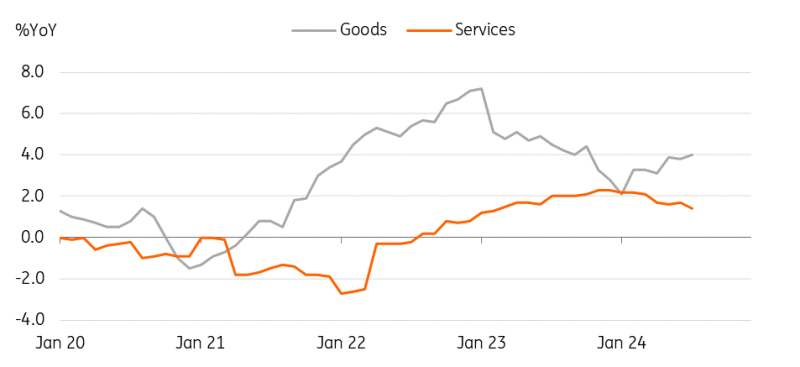Asia Morning Bites For Friday, Aug 23
Image Source: Unsplash
Global Macro and Markets
-
Global Markets: US Treasury yields have been quite volatile over the last week, and after falling on Wednesday, they rose on Thursday ahead of today’s much anticipated (and possibly overhyped) Jackson Hole speech by Jerome Powell. 2Y yields rose 7.3 basis points yesterday, and yields on 10Y Treasuries rose 5.1bp to 3.852%. Markets are pricing in a full 25bp rate cut at the September FOMC meeting, and about a 25% chance of 50bp, so there is still scope for today’s speech to excite or disappoint markets. However, as any decision that deviates from market pricing will rest on as yet unknown data, it is hard to see how Powell can commit to much beyond some easing of some sort in September, and even then, only barring data accidents. EURUSD eased back a bit to 1.1116 yesterday, and that has helped pull the AUD back to just over 67 cents. Cable was steady at 1.3095 but the JPY also weakened a touch, rising back to 146.12 ahead of BoJ Governor Ueda’s testimony to parliament about the recent market volatility. Asian FX was mostly weaker against the USD on Thursday. The Philippines is off today so the PHP has not yet reflected broader dollar gains. The IDR propped up the bottom of the Asia pack on Thursday, as tensions flared over some proposed legislative changes, though these have since been dropped. The KRW was also weaker after the BoK hinted at forthcoming rate cuts at their meeting.
US stocks had a poor day on Thursday. The S&P 500 fell 0.89% and the Nasdaq fell 1.67%. Chinese stocks had a better day. The CSI fell 0.26%, but the Hang Seng rose 1.44%.
G-7 Macro: Yesterday was quiet in the G-7 macro space. We did get a lot of PMI data, and that was mostly more upbeat. However, in the case of the European PMIs, there might have been an Olympics effect. US PMIs were more mixed, with a weaker manufacturing index, but stronger services. Jobless claims nosed slightly and insignificantly higher. Today, we get Eurozone inflation expectations figures, which may help the ECB to cross the line and cut rates again in September, though they are doing their best not to pre-commit.
US July new home sales will be largely overlooked given the Powell Jackson Hole speech later today.
-
Japan: Japanese consumer inflation stayed at 2.8% YoY in July for the third month in a row, slightly above the market consensus of 2.7%. Excluding fresh food, core inflation ticked up to 2.7% YoY, in line with market consensus, accelerating since April 2024. The most notable gain was from energy prices (12.0%) which was mainly due to the end of the energy subsidy program. However, the subsidy programme will resume for three months from August, adding noise to the data in the coming months. Sticky core inflation will continue to support the BoJ’s policy normalization. However, service price inflation decelerated to 1.4% in July (vs 1.7% in June) and could give a reason for the BoJ to slow down its normalization pace. Today Governor Ueda will be at parliament to explain the BoJ’s monetary policy. We expect him to tone down his hawkish message and ease market concerns about rapid policy changes. We have pushed back the next BoJ rate hike from October to December, as the BoJ is likely to remain on hold until the market digests the Fed’s rate cuts. We believe that macro conditions will continue to support BoJ rate hikes, with inflation likely to show its stickiness and the recovery in consumption and wage growth strengthening.
-
Singapore: Inflation data for July may show no progress from June, and the headline index may even move slightly higher to 2.5% YoY from 2.4%. This is mostly base effect driven though and the core series will likely show stability at 2.9%. That’s still too high, so the prospects for any easier monetary stance from the Monetary Authority of Singapore anytime soon look dim
-
Taiwan: The July industrial production data will be published in the afternoon. Year-on-year growth has been in the mid-teens in the last three months, and markets are looking for a slight pullback in today’s data to around 12.2% YoY, a little softer than our 13.0% YoY forecast. This growth will likely moderate further in the months ahead.
Slowing service prices would give a reason for the BoJ to stand pat for a while

Source: CEIC
What to look out for: South Korea BoK base rate, regional PMIs
August 23rd
Japan: July national CPI
Singapore: July CPI NSA
US: Jackson Hole Powell speech
More By This Author:
Asia Week Ahead: A Week Of Upbeat Data BeckonsEurozone Wage Growth Drops Drastically, Paving The Way For A September Cut
Eurozone PMI Picks Up In August Amid Olympics Boost
Disclaimer: This publication has been prepared by ING solely for information purposes irrespective of a particular user's means, financial situation or investment objectives. The information ...
more



